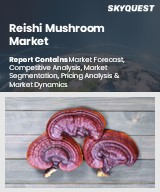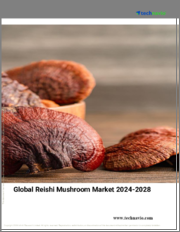
|
시장보고서
상품코드
1636312
세계의 영지버섯 시장 : 형태별, 특성별, 최종사용자별, 지역별(2025-2033년)Reishi Mushroom Market by Form (Liquid, Powder), Nature (Organic, Conventional), End User (Food and Beverages, Pharmaceutical, Nutraceutical and Dietary Supplement, Cosmetics and Personal Care), and Region 2025-2033 |
||||||
영지버섯 시장 세계 시장 규모는 2024년 42억 달러에 달했습니다. 향후 IMARC Group은 2033년까지 74억 달러에 달할 것으로 예상하며, 2025-2033년간 6.6%의 연평균 성장률(CAGR)을 보일 것으로 전망하고 있습니다. 만성 및 급성 질환의 유병률 증가, 천연 및 유기농 제품에 대한 수요 증가, 건강 보조 식품에 대한 제품의 급속한 사용은 시장을 이끄는 주요 요인 중 일부입니다.
영지버섯(Ganoderma lucidum)라고도 불리는 영지버섯는 약용 버섯의 일종으로, 수천년동안 중국 전통 의학에서 건강상의 이점으로 인해 사용되어 왔습니다. 영지버섯은 두꺼운 적갈색 우산, 독특한 광택이 나는 표면, 나무와 같은 질감을 가진 검은 색의 큰 식용 버섯으로 건조 또는 분말 형태로 섭취하거나 추출물을 보충제로 섭취합니다. 영지버섯은 항염증, 항산화, 항종양, 면역력 향상 효과가 있는 것으로 알려져 있습니다. 트리테르페노이드, 다당류, 펩타이드 글리칸 등 다양한 활성 화합물을 함유하고 있어 약효에 기여합니다. 영지버섯는 백혈구 및 기타 면역 세포의 생성을 자극하고, 인지 기능을 향상시키고, 스트레스를 줄이고, 에너지 수준을 높이는 한편, 전신 염증을 억제하는 항염증 작용이 풍부하여 여러 가지 의학적 효과를 제공합니다.
영지버섯 시장 동향 :
이 시장을 크게 견인하는 것은 전 세계적으로 천연 및 유기농 제품에 대한 수요가 증가하고 있다는 점입니다. 그 배경에는 버섯의 다양한 약효에 대한 소비자들의 인식이 높아진 것도 한몫하고 있습니다. 이에 따라 당뇨병, 비만, 심혈관 질환 등 만성질환에 대한 자연요법으로의 패러다임 전환이 시장에 활력을 불어넣고 있습니다. 또한, 만성질환 유병률 증가와 이러한 질환을 앓고 있는 노령 인구 증가는 시장 전망을 밝게 하고 있습니다. 여기에 더해 다양한 건강보조식품의 제형에 영지버섯가 빠르게 활용되고 있는 것도 영지버섯 수요를 촉진하고 있습니다. 또한, 영지버섯은 영양가가 높아 채식주의자들의 식단에서 동물성 식품을 대체할 수 있는 식품으로 인기를 끌고 있는 점도 시장을 견인하고 있습니다. 이와는 별도로, 영지버섯 재배를 지원하는 여러 국가의 유리한 정부 정책도 시장의 중요한 성장 촉진요인으로 작용하고 있습니다. 또한, 노화 방지 및 항염증제로 사용되는 천연 유기농 미용 제품에 대한 수요 증가도 시장에 긍정적인 영향을 미치고 있습니다. 기타 시장 개척 요인으로는 채식주의의 부상, 가처분 소득 수준 증가, 광범위한 연구개발 활동 등이 있습니다.
본 보고서에서 다룬 주요 질문
- 세계 영지버섯 시장은 지금까지 어떻게 발전해 왔을까?
- 세계 영지버섯 시장 성장 촉진요인, 억제요인 및 기회는 무엇인가?
- 각 촉진요인, 억제요인, 기회가 세계 영지버섯 시장에 미치는 영향은?
- 주요 지역 시장은?
- 영지버섯 시장이 가장 매력적인 국가는 어디일까?
- 시장 형태별 분류는?
- 영지버섯 시장에서 가장 매력적인 형태는?
- 성질별 시장 분석은?
- 영지버섯 시장에서 가장 매력적인 특성은?
- 최종 사용자별 시장 분석은?
- 영지버섯 시장에서 가장 매력적인 최종 사용자는?
- 세계 영지버섯 시장 경쟁 구도는?
- 세계 영지버섯 시장의 주요 기업은?
목차
제1장 서문
제2장 조사 범위와 조사 방법
- 조사 목적
- 이해관계자
- 데이터 소스
- 1차 정보
- 2차 정보
- 시장 추정
- 보텀업 접근
- 톱다운 접근
- 조사 방법
제3장 주요 요약
제4장 서론
- 개요
- 주요 업계 동향
제5장 세계의 영지버섯 시장
- 시장 개요
- 시장 실적
- COVID-19의 영향
- 시장 예측
제6장 시장 분석 : 형태별
- 액체
- 시장 동향
- 시장 예측
- 분말
- 시장 동향
- 시장 예측
제7장 시장 분석 : 성질별
- 오가닉
- 시장 동향
- 시장 예측
- 기존
- 시장 동향
- 시장 예측
제8장 시장 분석 : 최종사용자별
- 식품 및 음료
- 시장 동향
- 시장 예측
- 의약품 및 식이보충제
- 시장 동향
- 시장 예측
- 화장품 및 퍼스널케어
- 시장 동향
- 시장 예측
제9장 시장 분석 : 지역별
- 북미
- 미국
- 캐나다
- 아시아태평양
- 중국
- 일본
- 인도
- 한국
- 호주
- 인도네시아
- 기타
- 유럽
- 독일
- 프랑스
- 영국
- 이탈리아
- 스페인
- 러시아
- 기타
- 라틴아메리카
- 브라질
- 멕시코
- 기타
- 중동 및 아프리카
제10장 성장 촉진요인 및 억제요인과 기회
- 개요
- 성장 촉진요인
- 성장 억제요인
- 기회
제11장 밸류체인 분석
제12장 Porter의 Five Forces 분석
- 개요
- 바이어의 교섭력
- 공급 기업의 교섭력
- 경쟁 정도
- 신규 진출업체의 위협
- 대체품의 위협
제13장 가격 분석
제14장 경쟁 구도
- 시장 구조
- 주요 기업
- 주요 기업 개요
- Alphay International Inc.
- Bio-Botanica
- Bristol Botanicals Limited
- DXN Holdings Bhd
- Hokkaido Reishi
- Mushroom Science
- Nammex
- Qingdao Dacon Trading Co.
- Ron Teeguarden Enterprises Inc
- The Mushroom Company
- Xi'an Greena Biotech Co. Ltd
The global Reishi mushroom market size reached USD 4.2 Billion in 2024. Looking forward, IMARC Group expects the market to reach USD 7.4 Billion by 2033, exhibiting a growth rate (CAGR) of 6.6% during 2025-2033. The rising prevalence of chronic and acute indications, augmenting demand for natural and organic products, and rapid product utilization in dietary supplements represent some of the key factors driving the market.
Reishi mushroom, also known as Ganoderma lucidum, is a type of medicinal mushroom that has been used in traditional Chinese medicine for thousands of years due to its purported health benefits. A large, dark-colored edible mushroom with a thick reddish-brown cap, distinctive glossy surface, and a woody texture, it is consumed in dried or powdered form, or as an extract in supplements. Reishi mushroom is known for its anti-inflammatory, antioxidant, anti-tumor and immune-boosting properties. It contains a variety of active compounds, including triterpenoids, polysaccharides, and peptidoglycans, which contribute to its medicinal properties. Reishi mushrooms provide several medical benefits, such as stimulating the production of white blood cells and other immune cells, helping improve cognitive function, reducing stress, boosting energy levels, while being rich in anti-inflammatory properties that can help to reduce inflammation throughout the body.
Reishi Mushroom Market Trends:
The market is majorly driven by the rising demand for natural and organic products across the globe. This can be attributed to the growing awareness regarding numerous medicinal properties of the mushroom among the consumers. In line with this, the paradigm shift toward natural remedies for chronic diseases, such as diabetes, obesity and cardiovascular diseases, is providing an impetus to the market. Also, the increasing prevalence of chronic diseases, along with the growing geriatric population that is more susceptible to developing these ailments, is creating a positive market outlook. In addition to this, the rapid product utilization in the formulation of a wide range of dietary supplements is propelling the demand for Reishi mushroom. The market is further fueled by the rising popularity of Reishi mushrooms as an alternative to animal-based products in vegan diets due to their high nutritional value. Apart from this, favorable government policies in several countries supporting the cultivation of Reishi mushroom is also acting as a significant growth-inducing factor for the market. Furthermore, the augmenting demand for natural and organic beauty products where Reishi mushroom is used as an anti-aging and anti-inflammatory agent is impacting the market positively. Some of the other factors contributing to the market include the emerging trend of veganism, inflating disposable income levels, and extensive research and development (R&D) activities.
Key Market Segmentation:
Form Insights:
- Liquid
- Powder
Nature Insights:
- Organic
- Conventional
End User Insights:
- Food and Beverages
- Pharmaceutical, Nutraceutical and Dietary Supplement
- Cosmetics and Personal Care
Regional Insights:
- North America
- United States
- Canada
- Europe
- Germany
- France
- United Kingdom
- Italy
- Spain
- Russia
- Others
- Asia Pacific
- China
- Japan
- India
- South Korea
- Australia
- Indonesia
- Others
- Latin America
- Brazil
- Mexico
- Others
- Middle East and Africa
- The report has also provided a comprehensive analysis of all the major regional markets, which include North America (the United States and Canada); Europe (Germany, France, the United Kingdom, Italy, Spain, Russia and others); Asia Pacific (China, Japan, India, South Korea, Australia, Indonesia, and others); Latin America (Brazil, Mexico, and others); and the Middle East and Africa. According to the report, Asia Pacific was the largest market for Reishi mushroom. Some of the factors driving the Asia Pacific Reishi mushroom market included the growing geriatric population susceptible to chronic ailments, escalating demand for natural and organic products, inflating disposable income, etc.
Competitive Landscape:
- The report has also provided a comprehensive analysis of the competitive landscape in the global reishi mushroom market. Competitive analysis such as market structure, market share by key players, player positioning, top winning strategies, competitive dashboard, and company evaluation quadrant has been covered in the report. Also, detailed profiles of all major companies have been provided. Some of the companies covered include Alphay International Inc., Bio-Botanica, Bristol Botanicals Limited, DXN Holdings Bhd, Hokkaido Reishi, Mushroom Science, Nammex, Qingdao Dacon Trading Co., Ron Teeguarden Enterprises Inc, The Mushroom Company, Xi'an Greena Biotech Co. Ltd, etc.
Key Questions Answered in This Report:
- How has the global reishi mushroom market performed so far, and how will it perform in the coming years?
- What are the drivers, restraints, and opportunities in the global reishi mushroom market?
- What is the impact of each driver, restraint, and opportunity on the global reishi mushroom market?
- What are the key regional markets?
- Which countries represent the most attractive reishi mushroom market?
- What is the breakup of the market based on the form?
- Which is the most attractive form in the reishi mushroom market?
- What is the breakup of the market based on the nature?
- Which is the most attractive nature in the reishi mushroom market?
- What is the breakup of the market based on the end user?
- Which is the most attractive end user in the reishi mushroom market?
- What is the competitive structure of the global reishi mushroom market?
- Who are the key players/companies in the global reishi mushroom market?
Table of Contents
1 Preface
2 Scope and Methodology
- 2.1 Objectives of the Study
- 2.2 Stakeholders
- 2.3 Data Sources
- 2.3.1 Primary Sources
- 2.3.2 Secondary Sources
- 2.4 Market Estimation
- 2.4.1 Bottom-Up Approach
- 2.4.2 Top-Down Approach
- 2.5 Forecasting Methodology
3 Executive Summary
4 Introduction
- 4.1 Overview
- 4.2 Key Industry Trends
5 Global Reishi Mushroom Market
- 5.1 Market Overview
- 5.2 Market Performance
- 5.3 Impact of COVID-19
- 5.4 Market Forecast
6 Market Breakup by Form
- 6.1 Liquid
- 6.1.1 Market Trends
- 6.1.2 Market Forecast
- 6.2 Powder
- 6.2.1 Market Trends
- 6.2.2 Market Forecast
7 Market Breakup by Nature
- 7.1 Organic
- 7.1.1 Market Trends
- 7.1.2 Market Forecast
- 7.2 Conventional
- 7.2.1 Market Trends
- 7.2.2 Market Forecast
8 Market Breakup by End User
- 8.1 Food and Beverages
- 8.1.1 Market Trends
- 8.1.2 Market Forecast
- 8.2 Pharmaceutical, Nutraceutical and Dietary Supplements
- 8.2.1 Market Trends
- 8.2.2 Market Forecast
- 8.3 Cosmetics and Personal Care
- 8.3.1 Market Trends
- 8.3.2 Market Forecast
9 Market Breakup by Region
- 9.1 North America
- 9.1.1 United States
- 9.1.1.1 Market Trends
- 9.1.1.2 Market Forecast
- 9.1.2 Canada
- 9.1.2.1 Market Trends
- 9.1.2.2 Market Forecast
- 9.1.1 United States
- 9.2 Asia-Pacific
- 9.2.1 China
- 9.2.1.1 Market Trends
- 9.2.1.2 Market Forecast
- 9.2.2 Japan
- 9.2.2.1 Market Trends
- 9.2.2.2 Market Forecast
- 9.2.3 India
- 9.2.3.1 Market Trends
- 9.2.3.2 Market Forecast
- 9.2.4 South Korea
- 9.2.4.1 Market Trends
- 9.2.4.2 Market Forecast
- 9.2.5 Australia
- 9.2.5.1 Market Trends
- 9.2.5.2 Market Forecast
- 9.2.6 Indonesia
- 9.2.6.1 Market Trends
- 9.2.6.2 Market Forecast
- 9.2.7 Others
- 9.2.7.1 Market Trends
- 9.2.7.2 Market Forecast
- 9.2.1 China
- 9.3 Europe
- 9.3.1 Germany
- 9.3.1.1 Market Trends
- 9.3.1.2 Market Forecast
- 9.3.2 France
- 9.3.2.1 Market Trends
- 9.3.2.2 Market Forecast
- 9.3.3 United Kingdom
- 9.3.3.1 Market Trends
- 9.3.3.2 Market Forecast
- 9.3.4 Italy
- 9.3.4.1 Market Trends
- 9.3.4.2 Market Forecast
- 9.3.5 Spain
- 9.3.5.1 Market Trends
- 9.3.5.2 Market Forecast
- 9.3.6 Russia
- 9.3.6.1 Market Trends
- 9.3.6.2 Market Forecast
- 9.3.7 Others
- 9.3.7.1 Market Trends
- 9.3.7.2 Market Forecast
- 9.3.1 Germany
- 9.4 Latin America
- 9.4.1 Brazil
- 9.4.1.1 Market Trends
- 9.4.1.2 Market Forecast
- 9.4.2 Mexico
- 9.4.2.1 Market Trends
- 9.4.2.2 Market Forecast
- 9.4.3 Others
- 9.4.3.1 Market Trends
- 9.4.3.2 Market Forecast
- 9.4.1 Brazil
- 9.5 Middle East and Africa
- 9.5.1 Market Trends
- 9.5.2 Market Breakup by Country
- 9.5.3 Market Forecast
10 Drivers, Restraints, and Opportunities
- 10.1 Overview
- 10.2 Drivers
- 10.3 Restraints
- 10.4 Opportunities
11 Value Chain Analysis
12 Porters Five Forces Analysis
- 12.1 Overview
- 12.2 Bargaining Power of Buyers
- 12.3 Bargaining Power of Suppliers
- 12.4 Degree of Competition
- 12.5 Threat of New Entrants
- 12.6 Threat of Substitutes
13 Price Analysis
14 Competitive Landscape
- 14.1 Market Structure
- 14.2 Key Players
- 14.3 Profiles of Key Players
- 14.3.1 Alphay International Inc.
- 14.3.1.1 Company Overview
- 14.3.1.2 Product Portfolio
- 14.3.2 Bio-Botanica
- 14.3.2.1 Company Overview
- 14.3.2.2 Product Portfolio
- 14.3.3 Bristol Botanicals Limited
- 14.3.3.1 Company Overview
- 14.3.3.2 Product Portfolio
- 14.3.4 DXN Holdings Bhd
- 14.3.4.1 Company Overview
- 14.3.4.2 Product Portfolio
- 14.3.5 Hokkaido Reishi
- 14.3.5.1 Company Overview
- 14.3.5.2 Product Portfolio
- 14.3.6 Mushroom Science
- 14.3.6.1 Company Overview
- 14.3.6.2 Product Portfolio
- 14.3.7 Nammex
- 14.3.7.1 Company Overview
- 14.3.7.2 Product Portfolio
- 14.3.8 Qingdao Dacon Trading Co.
- 14.3.8.1 Company Overview
- 14.3.8.2 Product Portfolio
- 14.3.9 Ron Teeguarden Enterprises Inc
- 14.3.9.1 Company Overview
- 14.3.9.2 Product Portfolio
- 14.3.10 The Mushroom Company
- 14.3.10.1 Company Overview
- 14.3.10.2 Product Portfolio
- 14.3.11 Xi'an Greena Biotech Co. Ltd
- 14.3.11.1 Company Overview
- 14.3.11.2 Product Portfolio
- 14.3.1 Alphay International Inc.
Kindly note that this only represents a partial list of companies, and the complete list has been provided in the report.












